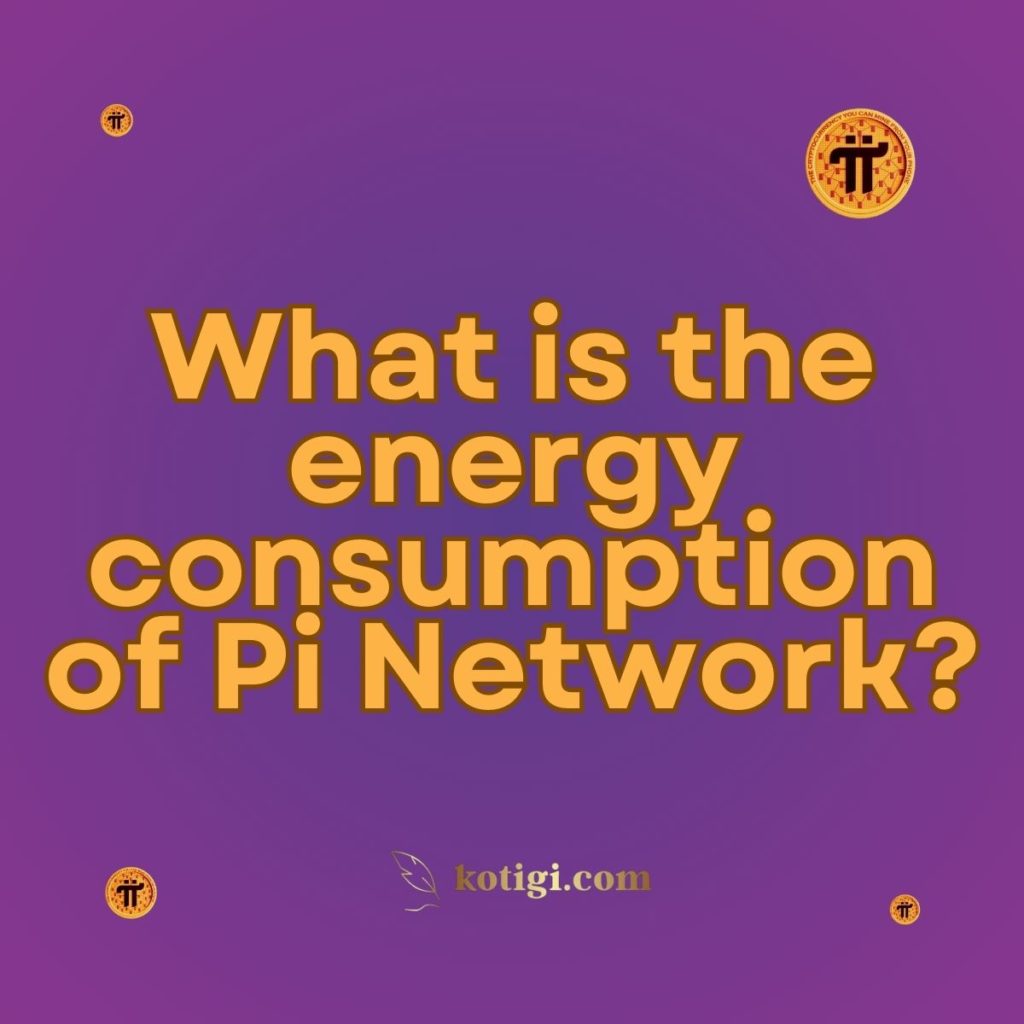
What is the energy consumption of Pi Network?
Pi Network’s energy consumption is significantly lower than traditional blockchain networks like Bitcoin, as it relies on a consensus algorithm that does not require resource-intensive mining. The network is designed to be energy-efficient, ensuring sustainability while still allowing a large number of users to participate.
Introduction
As environmental concerns surrounding cryptocurrency mining grow, the energy consumption of blockchain networks has become a critical topic of discussion. Pi Network, unlike traditional cryptocurrencies like Bitcoin, uses an energy-efficient consensus mechanism that drastically reduces its carbon footprint. This post examines the factors that make Pi Network’s energy consumption minimal and explores how its design promotes sustainability while supporting its growing user base.
Comparison table of key features of Pi Network vs others
the comparison table that highlights key features of Pi Network, Bitcoin, and Ethereum 2.0 (PoS) in a more visually appealing and informative manner:
| Feature | Pi Network | Bitcoin | Ethereum 2.0 (PoS) |
|---|---|---|---|
| Consensus Mechanism | Stellar Consensus Protocol | Proof of Work (PoW) | Proof of Stake (PoS) |
| Energy Consumption | Extremely Low | Very High | Moderate |
| Mining Hardware Requirement | None (Mobile Mining) | Requires Specialized Hardware | Minimal (Validator Nodes) |
| Carbon Footprint | Minimal | Significant | Reduced Compared to PoW |
| Transaction Speed | Very Fast (Seconds) | Moderate (10 mins on average) | Fast (Approx. 12 seconds) |
| Accessibility | Highly Accessible (Mobile-First) | Low Accessibility (Hardware Dependent) | Moderate (Requires Staking) |
| Sustainability Focus | Strong Emphasis on Sustainability | Limited Attention | Improving Sustainability Measures |
Analysis
This table provides a clear overview of how Pi Network differentiates itself from Bitcoin and Ethereum 2.0 in terms of key features, particularly regarding energy consumption and sustainability. Pi Network operates on the Stellar Consensus Protocol, enabling very low energy usage and allowing users to mine via their mobile devices, making it highly accessible to a broader audience.
In contrast, Bitcoin’s reliance on proof-of-work contributes to its high energy consumption and significant carbon footprint, making it less sustainable. While Ethereum 2.0’s transition to proof-of-stake improves its energy efficiency, it still requires users to engage in staking, which can limit accessibility compared to Pi Network’s user-friendly mobile platform.
Overall, Pi Network exemplifies a commitment to environmental responsibility and user engagement, showcasing a model that prioritizes sustainability and inclusivity in the rapidly evolving cryptocurrency landscape.
1. Energy-Efficient Consensus Mechanism
1.1 The Stellar Consensus Protocol (SCP)
Pi Network employs the Stellar Consensus Protocol (SCP), which differs from the energy-intensive proof-of-work (PoW) system used by Bitcoin. SCP allows Pi to secure its network without the need for high-powered computing, leading to significantly lower energy consumption.
1.2 No Need for Mining Hardware
Traditional cryptocurrency mining requires expensive and power-hungry hardware to validate transactions. Pi Network eliminates this need, as its consensus mechanism relies on users validating transactions through a mobile-friendly app, minimizing energy requirements.
1.3 Sustainability in Blockchain
The SCP-based system ensures that Pi Network is not only more accessible to the average user but also highly sustainable. By reducing the need for computational power, Pi lowers its environmental impact, making it a greener alternative to other cryptocurrencies.
2. Comparison to Traditional Cryptocurrencies
2.1 Bitcoin’s Energy Consumption
Bitcoin’s proof-of-work algorithm requires miners to solve complex mathematical problems, consuming vast amounts of electricity. As the number of miners increases, so does the total energy consumption, with Bitcoin now consuming as much energy as some small countries.
2.2 Ethereum’s Shift to Proof of Stake
Ethereum, another major blockchain, has recognized the energy concerns surrounding proof of work and is transitioning to a proof-of-stake (PoS) model with Ethereum 2.0. This will significantly reduce its energy consumption, but Pi Network already operates on a consensus protocol that inherently consumes far less energy.
2.3 Pi Network’s Low Impact
In comparison to these energy-intensive networks, Pi Network’s energy consumption remains extremely low. Its mobile-first, lightweight system is designed to be used by everyday users without the need for excessive electricity or specialized hardware.
3. Environmental Benefits of Pi Network
3.1 Reducing Carbon Footprint
Pi Network’s energy-efficient design significantly reduces its carbon footprint compared to traditional blockchains. Since users can mine Pi on their mobile devices without using excessive energy, the network has a much smaller environmental impact.
3.2 Accessibility and Sustainability
By lowering the barriers to entry, Pi Network creates an accessible platform where users can participate without contributing to the environmental degradation often associated with cryptocurrency mining. This accessibility, combined with low energy use, positions Pi as a more sustainable option in the crypto space.
3.3 Long-Term Sustainability Goals
As Pi Network continues to scale, maintaining its low energy consumption will be essential. The team behind Pi is committed to ensuring that the network remains energy-efficient, even as its user base grows, making sustainability a core focus of its development roadmap.
4. Scalability and Energy Efficiency
4.1 Energy Usage as the Network Grows
One of the main challenges for any blockchain is maintaining energy efficiency as the network scales. Pi Network is designed to handle this by ensuring that increased participation does not lead to exponential increases in energy use, thanks to its consensus algorithm.
4.2 Comparing Scalability to Other Networks
Many blockchain networks face scalability challenges as their user base expands, often requiring more energy to process additional transactions. Pi Network’s approach allows it to scale without significantly increasing its energy consumption, providing a sustainable path forward.
4.3 Green Blockchain Innovation
As more industries and users look for sustainable blockchain solutions, Pi Network’s low energy consumption could become a competitive advantage. The network’s ability to balance scalability with environmental responsibility places it in a unique position within the broader blockchain landscape.
5. Mobile-First Approach and Energy Savings
5.1 Mining on Mobile Devices
One of the key innovations of Pi Network is its ability to allow users to mine Pi from their mobile devices without draining battery life or consuming excessive data. This mobile-first approach is a stark contrast to traditional mining, which requires dedicated hardware and immense energy resources.
5.2 Encouraging Global Participation
Pi Network’s low energy requirements also make it more accessible to users in regions with limited access to high-powered computing resources. By allowing anyone with a smartphone to participate, Pi fosters global inclusion while maintaining its commitment to energy efficiency.
5.3 Balancing Participation and Efficiency
As Pi Network grows, balancing widespread participation with continued energy savings will be a challenge. However, the network’s mobile-first approach and its consensus algorithm give it a strong foundation to maintain energy efficiency while scaling.
6. The Future of Energy Efficiency in Blockchain
6.1 Potential for Further Innovation
Pi Network’s energy-efficient design is just the beginning of what could be a broader trend in blockchain development. As more networks prioritize sustainability, Pi’s early adoption of an eco-friendly consensus mechanism sets a strong example for future blockchain innovations.
6.2 Maintaining Efficiency with Growth
Ensuring that Pi Network remains energy-efficient as its user base grows will require ongoing innovations. The network’s commitment to energy savings will likely drive further developments aimed at reducing its environmental impact.
6.3 Pioneering Energy Efficiency in Blockchain
Pi Network’s focus on energy efficiency positions it as a pioneer in the blockchain space. As environmental concerns continue to rise, Pi’s model could influence other networks to adopt similar energy-saving technologies, potentially leading to industry-wide improvements in sustainability.
Conclusion
Pi Network’s energy consumption is notably lower than that of traditional blockchain networks like Bitcoin and Ethereum. By utilizing the Stellar Consensus Protocol, Pi ensures that its operations remain energy-efficient, making it a sustainable choice in the crypto landscape. With its mobile-first approach and commitment to maintaining low energy usage as it scales, Pi Network sets an example for other blockchain projects aiming to reduce their environmental impact.
Key Takeaways
- Pi Network’s consensus algorithm is highly energy-efficient compared to traditional proof-of-work models like Bitcoin.
- The mobile-first design allows users to mine Pi without consuming significant energy or requiring specialized hardware.
- Pi’s low energy consumption reduces its carbon footprint and makes it a sustainable choice in the blockchain ecosystem.
- As the network grows, scalability will remain a focus, ensuring that increased participation does not lead to higher energy usage.
- Pi Network’s emphasis on sustainability positions it as a pioneer in environmentally responsible blockchain technology.





